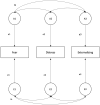Age-Related Variations of Genetic and Environmental Contributions to the Covariation of Fear, Distress and Externalizing Symptoms: A Twin Study in Childhood and Adolescence
- PMID: 36694087
- PMCID: PMC11362379
- DOI: 10.1007/s10578-023-01498-w
Age-Related Variations of Genetic and Environmental Contributions to the Covariation of Fear, Distress and Externalizing Symptoms: A Twin Study in Childhood and Adolescence
Abstract
The frequency with which Internalizing and Externalizing symptoms co-occur suggests that, behind both domains, there may be a common susceptibility represented by a general psychopathology factor. However, it's still unclear whether this common susceptibility is affected by age-related variations. Internalizing (i.e., Fear and Distress) and Externalizing symptoms were evaluated in 803 twin pairs from the population-based Italian Twin Registry. Model-fitting analysis was performed separately in the 6-14 and 15-18 age groups to estimate genetic and environmental contributions to the covariance among symptoms. For the 6-14 group, a multivariate Cholesky model best fitted the data, while, for the 15-18 group, the best fit was provided by a Common Pathway model in which nearly 50% of total variance of each trait was mediated by common genetic factors. Our findings support a common susceptibility behind Internalizing and Externalizing symptoms, mainly genetic in origin, that becomes more evident at the beginning of puberty.
Keywords: Children and adolescents; Internalization externalization; Latent susceptibility factor; Twin study.
© 2023. The Author(s).
Conflict of interest statement
The authors declare that they have no conflicts of interest.
Figures
Similar articles
-
The co-occurrence between internalizing and externalizing behaviors. A general population twin study.Eur Child Adolesc Psychiatry. 2008 Mar;17(2):82-92. doi: 10.1007/s00787-007-0639-7. Epub 2007 Sep 10. Eur Child Adolesc Psychiatry. 2008. PMID: 17846816
-
Negative affect shares genetic and environmental influences with symptoms of childhood internalizing and externalizing disorders.J Abnorm Child Psychol. 2013 Apr;41(3):411-23. doi: 10.1007/s10802-012-9681-0. J Abnorm Child Psychol. 2013. PMID: 23011215 Free PMC article.
-
Common genetic and nonshared environmental factors contribute to the association between socioemotional dispositions and the externalizing factor in children.J Child Psychol Psychiatry. 2013 Jan;54(1):67-76. doi: 10.1111/j.1469-7610.2012.02621.x. Epub 2012 Sep 28. J Child Psychol Psychiatry. 2013. PMID: 23017065 Free PMC article.
-
Personality dimensions as common and broadband-specific features for internalizing and externalizing disorders.J Abnorm Child Psychol. 2013 Aug;41(6):939-57. doi: 10.1007/s10802-013-9730-3. J Abnorm Child Psychol. 2013. PMID: 23474797 Free PMC article.
-
Genetic and Environmental Contributions to the Covariation Between Cardiometabolic Traits.J Am Heart Assoc. 2018 Apr 18;7(9):e007806. doi: 10.1161/JAHA.117.007806. J Am Heart Assoc. 2018. PMID: 29669715 Free PMC article.
Cited by
-
Exploring the Relationship of Cognitive Disengagement Syndrome and Attention Deficit/Hyperactivity Disorder with Emotional Dysregulation: A Twin Study in Childhood and Adolescence.Methods Protoc. 2025 Aug 11;8(4):94. doi: 10.3390/mps8040094. Methods Protoc. 2025. PMID: 40863744 Free PMC article.
References
Publication types
MeSH terms
LinkOut - more resources
Full Text Sources



